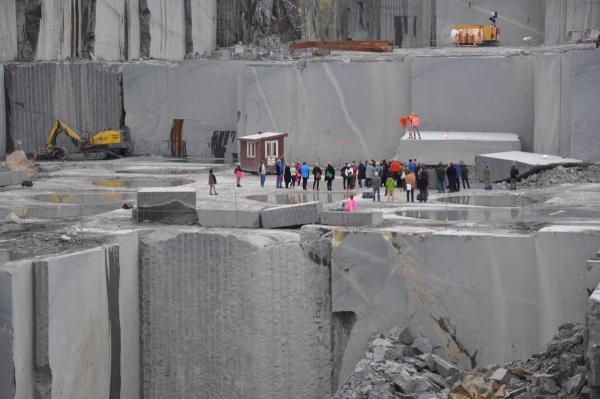
This Is What Creates the Seasons and the Passing of the Year, and that Rules over All Visible Things
2015
Performance
Performed with Kompani kunstgress and Jennie Hagevik Bringaker.
Six iconic sculptures from ancient Greek art history are staged in a stone quarry. The audience wanders through the quarry with a guide (Marianne Heier) as if in a sculpture park or a museum. The guide performs a monologue based on texts by, among others, Ernst Gombrich, Michelangelo Buonarroti, Griselda Pollock and Tor Ulven. It draws parallels between classical Greek sculpture and the development of Western canon and socio-political structure: from the Archaic period (600-480 BC) via the classic style (480-330 BC) and the Hellenistic style (323-50 BC). The aesthetic development of the sculptures in this time span reflects developments in the society in which they were created; increasing dynamics, physical detail and individuality occur in parallel with democratic development and individual participation in political decisions. The guide's perspective keeps shifting, highlighting different, sometimes conflicting, interpretations of art history and its significance. One can say that the project is about art's continuous relevance for mankind, its importance and function through - and across - history. The performance touches indirectly on contemporary conditions for art production, its autonomy and survival, both on a local and international level.
Ph.: Kristine Jakobsen
Sound: Erlend Hogstad
Light: Tobias Leira
Fremført med Kompani kunstgress og Jennie Hagevik Bringaker.
Seks ikoniske skulpturer fra antikk gresk kunsthistorie iscenesettes i et steinbrudd. Publikum vandrer gjennom bruddet sammen med en guide (Marianne Heier) som om de var i en skulpturpark eller et museum. Guiden fremfører en monolog basert på tekster av blant andre Ernst Gombrich, Michelangelo Buonarroti, Griselda Pollock og Tor Ulven. Den trekker paralleller mellom klassisk gresk skulptur og utviklingen av vestlig kanon og samfunnsoppbygning: fra den arkaiske perioden (600 – 480 f.Kr.) via den klassiske stilen (480 – 330 f.Kr.) og til den hellenistiske stilen (323 – 50 f. Kr.). Den estetiske utviklingen i skulpturene i dette tidsspennet avspeiler utviklingen i samfunnet de ble skapt i; økende dynamikk, fysisk detaljering og individualitet oppstår parallelt med at demokratiet utvikles og individet artikuleres som politisk deltaker i samfunnet. Guidens perspektiv veksler stadig, og belyser forskjellige, tildels motstridende forståelser av kunsthistorien og dens betydning. Dypest sett kan man si at prosjektet handler om kunstens kontinuerlige relevans for menneskeheten, og dens funksjon gjennom - og på tvers av - historien. Performancen berører indirekte også vår tids vilkår for kunsten, dens autonomi og overlevelsesevne, både på et lokalt og et internasjonalt plan.
Foto: Kristine Jakobsen
Forsidebilde fra performance i Montoso, Italia. Foto: Nicolò Roccatelli
Lyd: Erlend Hogstad
Lys: Tobias Leira